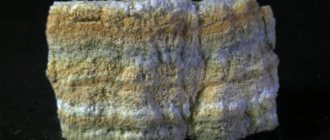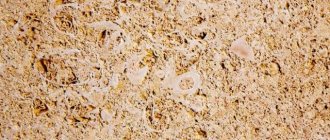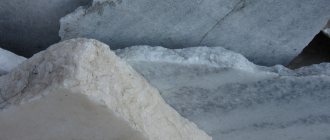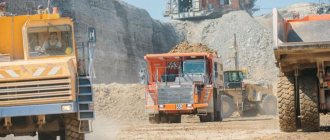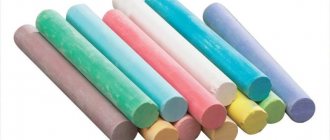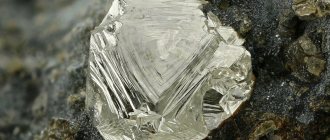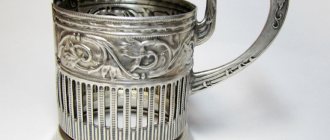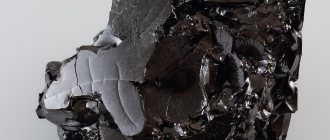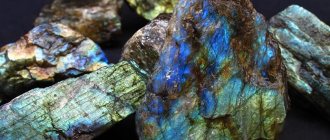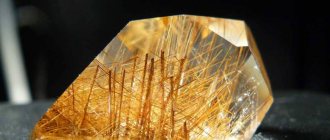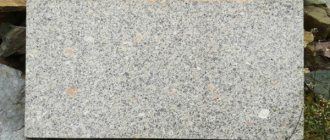| Category | Plutonic rocks |
| Title in English | Labradorite |
| Formula | SiO2 45-52% |
| Group | Labradorite group |
| Color | Colorless, White, Gray, Reddish, Bluish, Greenish, Black, Brown, Blue |
| Stroke color | Colorless |
| Shine | Glass |
| Transparency | Transparent, Semi-transparent |
| singonia | Triclinic |
| Hardness | 6 |
| Cleavage | Perfect |
| Density, g/cm³ | 2,68 — 2,74 |
| Kink | Conchoidal, Uneven |
| origin of name | The name of this rock was invented by the German geologist Ferdinand Senft. Since labradorite is an accumulation of the silicate mineral labradorite, the scientist could only draw an analogy and form a new name. To avoid confusion, a proposal was made to rename the stone to labradite, but this idea did not receive widespread support. |
Labradorite is an igneous plutonic basic normal-alkaline rock, a type of anorthosite and belongs to the gabbroid family. It contains the mineral labradorite, as well as admixtures of pyroxene and other ore minerals. The name of the breed is associated with the Labrador Peninsula in North America. Polished labradorite has a blue, red or yellow iridescence. The mineral is widely used as an ornamental and facing stone.
Story
— Advertising —
The unusual iridescent rock on the Labrador Peninsula was once discovered by the Indians, but it did not become popular among them. Archaeologists also found fragments of labradorite in Viking settlements near Labrador and Newfoundland.
For a long time, this rock was forgotten and returned to mineralogy only at the end of the 18th century, when the German scientist Abraham Gottlieb Werner systematized the previously accumulated knowledge, described labradorite and gave it a name after the Canadian deposit. After this, the rock was still considered rare and the search for its deposits continued in other parts of our planet.
They were successful and today labradorite is mined in Madagascar and Ukraine, Finland and Yakutia, the USA and Mexico.
Later, scientists found out that people used labradorite in construction, but did not identify it as an independent rock. And now materials are made from it for cladding, interior decoration, and decorative covering of furniture. Unusual and interesting designs are also used in jewelry.
Why were Labradors bred?
Labradors were originally bred for hunting. Therefore, these dogs must remain light and energetic. The ideal height at the withers for a male dog is 57-62 cm with an ideal weight of 29-36 kg. Bitches are always smaller than males, and with a height of no more than 55 cm they can weigh up to 31.5 kg.
Interesting materials:
How to calculate tax according to the simplified tax system? How to calculate taxes for individual entrepreneurs? How to calculate taxes in the USA? How to calculate the deadline for a tax demand? How to calculate transport tax 2022? How to calculate land tax? How to deregister a cash register with the tax office? How to deregister a sold car from tax registration? How to report a gray salary to the tax office? How to inform the tax office about a change of legal address?
Physico-chemical characteristics
— Advertising —
Labradorite crystals are translucent or translucent, they are tabular in shape, or occur in the form of granular aggregates that look like pieces of a candle.
The surface of labradorite chips has a bright glassy sheen; it seems to be covered with a thin mesh made of millions of tiny shining particles. This luster also has a pronounced iridescent glow, due to which the stone shimmers in the sun. This effect is connected, on the one hand, with the fracturing of the stone, and on the other hand, with impurities of barium, strontium, magnesium and potassium compounds.
The color range of labradorite is varied and includes brown, gray and black with gold, blue and red tints.
It is an intrusive rock with a holocrystalline, uniformly crystalline, coarse-grained structure, massive texture, and specific gravity of 2.7 g/cm3.
Labradorite deposits occur in the form of laccoliths, lopoliths, dikes, and stocks. A distinctive feature of the breed is a blue glow on the edges.
Varieties
Depending on the spectrum of light glare, the following types of Labradorite are distinguished:
- Spectrolite (“Rainbow Moonstone”) is a mineral that shines in all the colors of the rainbow. It is rare, found only in Finland.
- “Black Moonstone” is a dark-colored labradorite with blue-blue iridescence. It is also called tausin (for its resemblance to a peacock feather) and “Madagascar moonstone” (since its homeland is the island of Madagascar).
- Sunstone (“Oregon Sunstone”) is a mineral with an amazing golden iridescence. Mined in the USA (Oregon).
- Lynx eye - it is characterized by bright green iridescence.
- Andesine-labradorite. The stone was first mined in the Andes (South America), and was therefore called andesine (labradorite is the English name for labradorite). The hue is usually orange-reddish with traces of green and yellow. The color can also be red, honey red, amber, yellowish, green. In bright light, labradorescence appears in the form of a metallic sheen.
Magic properties
It is believed that labradorite takes its magical power from the mysterious and enigmatic Moon, at a time when it is hidden as much as possible by the shadow of the Earth.
For this reason, the stone prevents its owner from committing bad deeds and is even capable of punishing them. Magicians and sorcerers use labradorite to establish connections with the worlds of spirits. It is believed that in this case the mineral helps create conditions for two-way communication, but it is not able to force the spirit to talk with a person. At the same time, otherworldly forces can respond to the action of the stone not always in a positive way. For this reason, at all times, labradorite was used exclusively by experienced and powerful magicians and sorcerers.
Medicinal properties
In lithotherapy, labradorite is used to treat eye and brain diseases. It is believed that it helps relieve tension in stressful situations, helps normalize metabolism, and in the treatment of colds and rheumatism. Labradorites normalize hormonal disorders and reduce high blood pressure.
Applications
Labradorite is a high-quality facing stone that is used in architecture.
Thus, it was used for cladding Moscow metro stations and various buildings in the city. Specimens of the breed, which are distinguished by their bright iridescent blue and green colors, are used as decorative and ornamental stones. Despite its brightness and attractive shine, labradorite is fractured in its structure, so beads, earrings and pendants are made from large samples of it relatively rarely. When set in metal, labradorite becomes resistant to damage. Samples of high quality and beautiful color are cut into cabochons and used as inserts in a wide variety of jewelry.
The greatest demand among jewelers is for translucent labradorites, which are used as ring inserts. They are found mainly in deposits in Australia, and in terms of quality and external characteristics they have no equal.
Bright blue labradorites are mined in Finland and Norway, since they are very rare and such specimens are very expensive. Dark-colored labradorites with bright iridescent blue flowers were recently discovered in China.
Place of Birth
Areas of distribution. Canada; Ukraine, Middle Urals, Karelia (Russia); in the gabbro massifs near Börigen, Waldheim, Hohenstein-Ernstthal, Helmühle near Penig (Saxon Granulite Mountains); Labradorite is part of the basalts and diabases of the Ore Mountains and the Thuringian Forest in its regional region, as well as the diabases of the Harz (Germany). Widely distributed mineral.
The first discovery of labradorite was made on St. Paul Island, near Nain, off the coast of the Labrador Peninsula, Canada (Werner, 1780), where its classic examples have excellent iridescence. In fissuring masses, labradorite with iridescence is found in many anorthositic massifs of the gabbro-anorthositic (with labradorite) formation, developed within the tectonic sutures of crystalline shields (Canadian, Ukrainian, Anabar, etc.). Rock-forming labradorite, the content of which reaches 97%, forms phenocrysts up to several cm in size here in association with olivine, hypersthene, amphibole, magnetite and ilmenite. Areas with iridescent labradorite form layers or lenses stretching for hundreds of meters with a thickness of up to 30-50 m. The most famous outcrops of such anorthosites are in the west of the Labradorite Peninsula, in the provinces of Ontario and Quebec (Canada), as well as in the Adirondack Mountains north of New York. York (USA), in the Kiev (Korsun-Novomirgorodsky massif) and Volyn (Korostensky and Golovinsky massifs) regions in Ukraine (Kamenny ford on the Bystrievka river, near the village of Khlystunovka and Malaya Gorodishche, on the Irsha river near the village of Goroshki, Paromovka village, Golovnya village, Gorbylevo village), in the Gorodishchensky massif near the city of Zyryanovsk (Altai), in the Dzhugdzhursky massif in Siberia. In Norway, the blue-gray Labrador is known from Tvedestrande, South. Norway. In the Caucasus - in Georgia near the village. Java, Gori region.
It is emphasized that it is impossible to explain the occurrence of Labradorite cumulates in anorthosite interbeds within the Middle Bendid sequence in the layered Stillwater complex. Based on the study of Sr and Nd isotopes, it is assumed that the anorthosites of the Laramie complex, pcs. Wyoming, USA, arose as a result of the assimilation of bark rocks.
Labradorite is a rock-forming mineral of the main volcanic rocks - picritobasalts (An65-95), olivine basalts and dolerites (An50-80), basalts and dolerites (An40-70), leucobasalts and leucodolerites (An40-90) and hypersthene basalts (An50-90) , passing in composition, on the one hand, into bytownite, and on the other, into andesine. It is also common in subalkaline varieties of these rocks - subalkaline olivine basalts and dolerites and subalkaline leucobasalts (An40-85), as well as in trachybasalts and trachydolerites (An20-70) and shoshonites (An40-75) in association with anorthoclase or sanidine. In alkaline basaltoids, labradorite (less commonly bytownite) is associated with feldspathoids, pyroxene and olivine in tephrites. In plutonic rocks of the normal series, labradorite (bytownite) is the rock-forming mineral of gabbro and norite; in alkaline basic rocks of teralites and teshenites (An50-90).
If in volcanic rocks labradorite is clearly zonal, highly variable in composition, then in plutonic rocks its composition is more consistent. For example, in the rocks of the Yoko-Dovyrensky layered ultramafic-mafic pluton, the Baikal region, intercumulus plagioclase in ultramafics varies within An61-75 and has a lower basicity than the cumulative one in troctolites and olivine gabbroids (An79-85); the basicity of the latter decreases in the top of the pluton - in granophyric gabbro-norites (An61-43). In the layered massifs of Somalia, its composition varies within An58-65 in Duduba, An56-68 in Gul-Sakara, An56-75 in Rakdasafak, and only in Hamar, where uralite gabbros with prehnite and albite veinlets are present, is it more acidic (An35- 61).
Cumulus and interstitial plagioclases examined from pyroxenites, anorthosites, chromite anorthosites, norites and gabbros of the lower East Bushveld Complex, South Africa, were all assigned to the low, highly ordered series based on X-ray data.
Less commonly, labradorite is observed in rocks of medium basicity, usually in the cores of zoned grains. Isolated outcrops have been described from the Verespatak quartz andesite to the northeast, from Abrudbaanya, Romania, in the vicinity of St. Petersburg, near Sveaborg on the island of Mijone and in Ojamo, Finland, in Essex, pcs. New York, USA.
In amphibolites of Archean age, labradorite is distributed in Eastern Canada, north of New York, Greenland, Norway, Sweden, and Finland.
Cases of reverse zoning in plagioclase grains are especially studied. In granulites trapped as xenoliths in the granite gneisses of the Manalur fault zone, pcs. Tamil Nadu, India, An55-58 labradorite porphyroblasts have An75-85 rims. Since unzoned plagioclase is associated here with amphibole and clinopyroxene, and zonal plagioclase with orthopyroxene, the authors believe that the reason for the reverse zoning is the release of Ca when amphibole is replaced by orthopyroxene during metamorphism. In the case of porphyritic oligoclase-andesine phenocrysts An18-42 in the basalts of Gombe-Biu, Nigeria, overgrown with rims of more basic plagioclase and included in the groundmass of basalt containing labradorite of composition An54-62, an intertelluric origin of the phenocrysts is assumed, similar to the formation of anorthoclase megacrysts in alkaline basalts (t i.e. their genetic connection with different magmas).
Interesting finds of labradorite in pegmatites of gabbro-norites of Volyn (village Paromovka) in association with orthoclase, quartz of several generations, amethyst, biotite, augite, apatite, calcite, etc. Porphyry phenocrysts of aventurine labradorite (sunstone) are described from Modoc County, pcs. . California, USA, and Lake County, pc. Oregon, USA.
In Russia, iridescent labradorite was discovered in boulders in the Peterhof area (1874-1785), was used in jewelry and was highly prized. At the beginning of the 19th century. Primary deposits of labradorite were discovered in Ukraine. The main deposits in the CIS are currently concentrated in the Korostensky and Volodarsko-Volynsky massifs in Volyn and Korsun-Novomirgorodsky in the Dnieper region (Ukraine). There are 26 known deposits here, of which six have been studied and two are being developed. Based on color, structure and iridescence, four types of Volyn labradorites are distinguished: “Golovinsky”, “Turchinsky”, “Vasilkovsky” and “Krapyvinsky”. For the stone-cutting and jewelry industries, the first two are mainly used. The Golovinskoye field has been developed since 1901. The Gorodishchensky pluton in Altai (near the city of Zyryanovsk) and the Dzhugdzhursky pluton in Siberia are promising.
Colors
The color palette of natural labradorite includes shades of gold, violet-red, blue-green, blue-orange.
The last two variations are especially popular in jewelry. Labradorite is interesting in jewelry because its surface is always dotted with strange patterns of several colors. In the bright sun, the stone shines brightly and shimmers in different colors.
Price
The price of Labradorite depends on the variety, the degree of Labradorization, and the size of the stone.
The cost of souvenirs made from this mineral consists of the price of it and the work of the craftsman, and for jewelry it is also important how much the metal of the frame costs.
Examples of prices in Russian online stores:
- cabochon (33 x 28 x 8 mm) - 740 rub. ;
- earrings— RUB 2,299 ;
- 925 sterling silver ring – RUB 3,400.
Read also : Malachite - a stone of fulfillment of desires
How to care for labradorite
Labradorite, as a durable and stable stone, is quite undemanding in care.
Both running water and soap solutions are suitable for cleaning it. An unset stone may have a cracked structure. In this case, it is protected from sudden temperature changes so that large, massive, solid products do not deteriorate.
For Taurus
Labradorite is a talisman stone for Taurus women. It will also become a support and protection. Among the huge number of varieties of this mineral, there are certain types that can successfully become assistants in any field of activity. Labradorite is a talisman stone for women. It will improve the mood of Taurus and improve their well-being. It will act on the body exactly as the owner of the mineral wants it. The stone helps its owner to do wise things.
Labradorite and zodiac sign
Labradorite is most favorable to representatives of the water and air elements. His relationships are especially good with such zodiac signs as Pisces and Libra. However, this stone must be selected individually, since its relationship with the owner is often difficult.
Compatibility with other stones
Labradorite is a mineral of the Earth , so it gets along well with its “elemental” brothers: malachite, jasper, lapis lazuli, etc.
Water stones are also suitable for his company , for example, opal, emerald, pearls.
Air minerals : with topaz, amethyst, sapphire and other “air” stones.
It is strictly incompatible only with “fire” stones: garnet, coral, spinel, etc.
Interesting facts about labradorite
- The minerals labradorite and labradorite are not the same thing. Labradorite's chemical composition is calcium aluminosilicate, and is famous for its high aesthetic qualities. In turn, labradorite is a rock that contains about 60% labradorite. Similar “relationships” are typical, for example, for feldspar and granite: the amount of spar in granite is about 60-65%.
- In terms of its physical characteristics, labradorite is very similar to granite: it has high density, strength, hardness and wear resistance. Even the uses of these stones are similar - they are widely used as cladding material. But granites are very widespread, and labradorites are rare.
